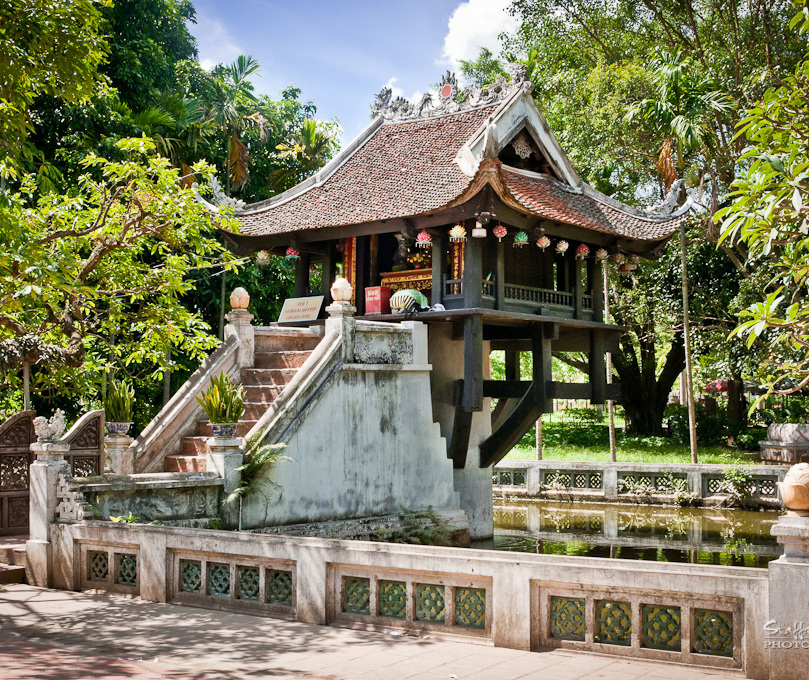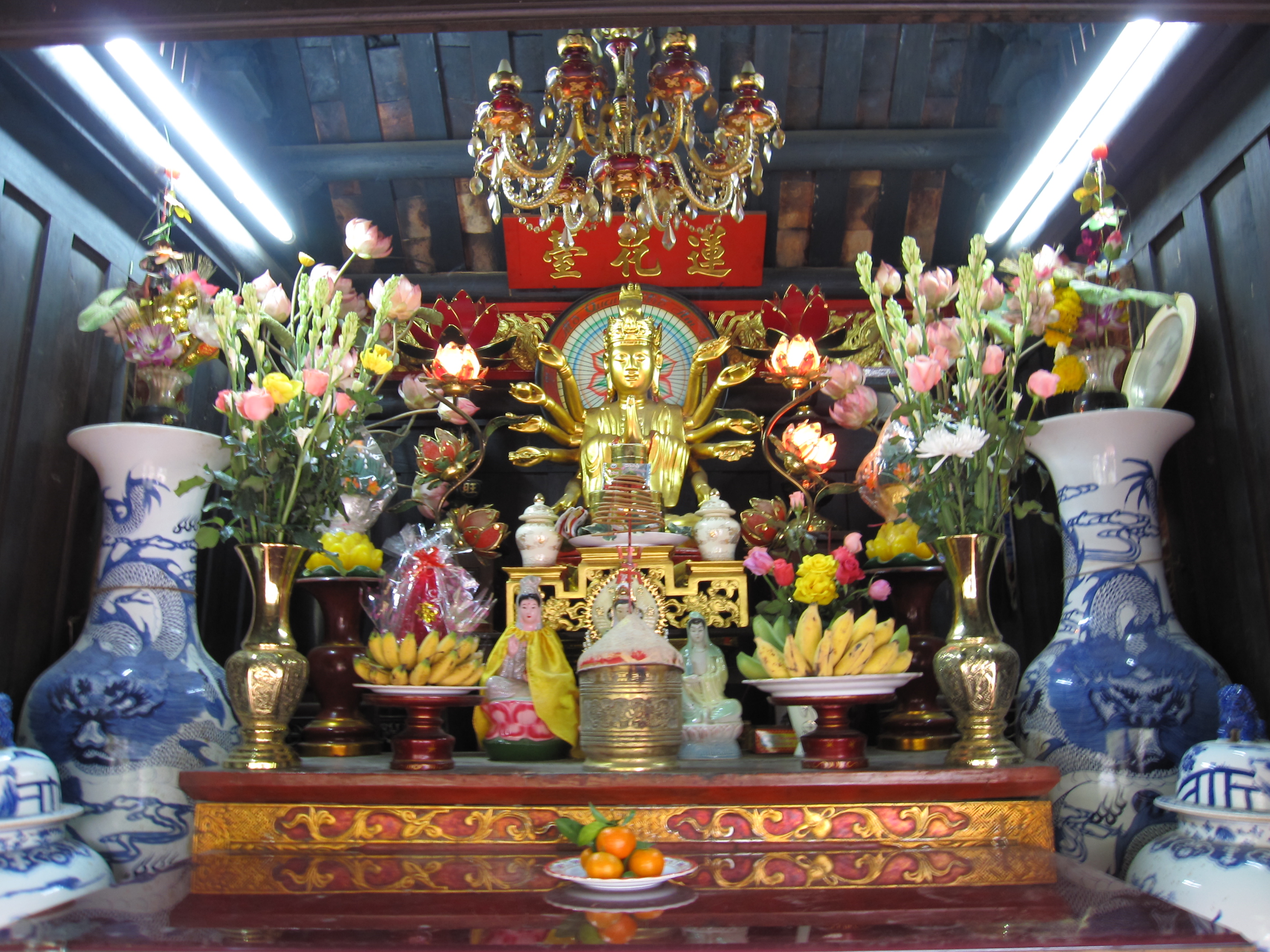Chùa Một Cột on:
[Wikipedia]
[Google]
[Amazon]

 The One Pillar Pagoda ( vi, Chùa Một Cột ), formally belongs to an architecture complex called (延祐寺) which means Extend Bless pagoda. The pagoda is a historic
The One Pillar Pagoda ( vi, Chùa Một Cột ), formally belongs to an architecture complex called (延祐寺) which means Extend Bless pagoda. The pagoda is a historic
 In the 1999 research paper, the folk culture researcher Nguyễn Hùng Vĩ gave evidence to prove: the One Pillar Pagoda's (Liên Hoa Đài's) architecture is similar to the ruin stone pillar of Dạm Pagoda. According to Dr. Trần Trọng Dương, the original architecture of Diên Hựu Pagoda is a geometric configuration of symbols of Buddhism called
In the 1999 research paper, the folk culture researcher Nguyễn Hùng Vĩ gave evidence to prove: the One Pillar Pagoda's (Liên Hoa Đài's) architecture is similar to the ruin stone pillar of Dạm Pagoda. According to Dr. Trần Trọng Dương, the original architecture of Diên Hựu Pagoda is a geometric configuration of symbols of Buddhism called
Photos of the One Pillar Pagoda
One Pillar Pagoda in Hanoi
{{Hanoi Tourism 11th-century Buddhist temples Buddhist temples in Hanoi Pagodas in Vietnam

Buddhist
Buddhism ( , ), also known as Buddha Dharma and Dharmavinaya (), is an Indian religion or philosophical tradition based on teachings attributed to the Buddha. It originated in northern India as a -movement in the 5th century BCE, and ...
temple in the central Ba Đình district (near the Thăng Long Citadel), Hanoi
Hanoi or Ha Noi ( or ; vi, Hà Nội ) is the capital and second-largest city of Vietnam. It covers an area of . It consists of 12 urban districts, one district-leveled town and 17 rural districts. Located within the Red River Delta, Hanoi is ...
, the capital of Vietnam. The most famous part of this architecture complex is (蓮花臺) (means Lotus Station) which is a temple with special structure: a building laid on one pillar. The original pagoda was built in 1049, had some additions and was perfected in 1105. It is regarded alongside the Perfume Temple, as one of Vietnam's two most iconic temples.
History
Lý dynasty
The temple was built by EmperorLý Thái Tông
Lý Thái Tông (chữ Hán: 李 太 宗; 29 July 1000 – 3 November 1054), personal name Lý Phật Mã, posthumously temple name Thái Tông, was the second monarch of the Lý dynasty, ruled Đại Việt from 1028 to 1054. He was consid ...
, who ruled from 1028 to 1054. According to the court records, Lý Thái Tông was childless and dreamt that he met the bodhisattva
In Buddhism, a bodhisattva ( ; sa, 𑀩𑁄𑀥𑀺𑀲𑀢𑁆𑀢𑁆𑀯 (Brahmī), translit=bodhisattva, label=Sanskrit) or bodhisatva is a person who is on the path towards bodhi ('awakening') or Buddhahood.
In the Early Buddhist schools ...
Avalokiteshvara, who handed him a baby son while seated on a lotus flower. Lý Thái Tông then married a peasant girl that he had met, and she bore him a son. The emperor constructed the temple in gratitude for this in 1049, having been told by a monk named Thiền Tuệ to build the temple, by erecting a pillar in the middle of a lotus pond, similar to the one he saw in the dream.
The temple was located in what was then the Tây Cấm Garden in Thạch Bảo, Vĩnh Thuận district in the capital Thăng Long (now known as Hanoi). Before the pagoda was opened, prayers were held for the longevity of the monarch. During the Lý dynasty era, the temple was the site of an annual royal ceremony on the occasion of Vesak
Vesak (Pali: ''Vesākha''; sa, Vaiśākha), also known as Buddha Jayanti, Buddha Purnima and Buddha Day, is a holiday traditionally observed by Buddhists in South Asia and Southeast Asia as well as Tibet and Mongolia. The festival commemora ...
, the birthday of Gautama Buddha
Siddhartha Gautama, most commonly referred to as the Buddha, was a wandering ascetic and religious teacher who lived in South Asia during the 6th or 5th century BCE and founded Buddhism.
According to Buddhist tradition, he was born in Lu ...
. A Buddha-bathing ceremony was held annually by the monarch, and it attracted monks and laymen alike to the ceremony. The monarch would then free a bird, which was followed by the people.
The temple was renovated in 1105 by Emperor Lý Nhân Tông and a bell was cast and an installation was attempted in 1109. However, the bell, which was regarded as one of the four major capital works of Vietnam at the time, was much too large and heavy, and could not be installed. Since it could not be tolled while left on the ground, it was moved into the countryside and deposited in farmland adjacent to Nhất Trụ Temple. This land was widely inhabited by turtles, so the bell came to be known as ''Chuông Quy Điền'', which means ''Bell of the Turtle Farmland''. At the start of the 15th century, Vietnam was invaded and occupied by the Ming dynasty
The Ming dynasty (), officially the Great Ming, was an imperial dynasty of China, ruling from 1368 to 1644 following the collapse of the Mongol-led Yuan dynasty. The Ming dynasty was the last orthodox dynasty of China ruled by the Han peo ...
. In 1426, the future Emperor Lê Lợi
Lê Lợi (, Chữ Hán: 黎利; c. 10 September 1384/1385 – 5 October 1433), also known by his temple name as Lê Thái Tổ (黎太祖) and by his pre-imperial title Bình Định vương (平定王; "Prince of Pacification"), was a Vietnam ...
attacked and dispersed the Chinese forces, and while the Ming were in retreat and low on weapons, their commanding general ordered that the bell be smelted, so that the copper
Copper is a chemical element with the symbol Cu (from la, cuprum) and atomic number 29. It is a soft, malleable, and ductile metal with very high thermal and electrical conductivity. A freshly exposed surface of pure copper has a pinkis ...
could be used for manufacturing weaponry.
After Lý dynasty
During Nguyễn dynasty, the pagoda was restored and rebuilt in 1840-1850 and 1922. The pagoda was dynamited in 1954. Contrary to what is commonly written, it was not destroyed by the French, but by a Vietnamese Lieutenant of the French Army who was severely punished. In 1955, Ministry of Culture ofDemocratic Republic of Vietnam
North Vietnam, officially the Democratic Republic of Vietnam (DRV; vi, Việt Nam Dân chủ Cộng hòa), was a socialist state supported by the Soviet Union (USSR) and the People's Republic of China (PRC) in Southeast Asia that existed f ...
restored the pagoda and the Lotus Station based on the architectural style that Nguyễn dynasty had left.
Architecture
Original architecture
There were some additions and be perfected in 1105 according to ''Đại Việt sử ký toàn thư
The ''Đại Việt sử ký toàn thư'' ( vi-hantu, 大越史記全書; ; ''Complete Annals of Đại Việt'') is the official national chronicle of the Vietnamese state, that was originally compiled by the royal historian Ngô Sĩ Liên under ...
'':''"Yi You (乙酉), (Long Phù) the fifth year (1105 AD), Song Chongning the fourth year. ..At that time, the emperor (Lý Thánh Tông Lý Thánh Tông (30 March 1023 – 1 February 1072), personal name Lý Nhật Tôn , temple name Thánh Tông, was the third emperor of the Lý dynasty and the 8th ruler of the Vietnamese kingdom Đại Việt. In his reign, Lý Thánh Tôn ...) repaired Diên Hựu pagoda to be more beautiful than before, dug Liên Hoa Đài lake (Lotus Station's lake), called Linh Chiểu lake. Outside the lake, there was a corridor running around, outside the corridor dug another lake called Bích Trì Lake, built bridges to cross. In front of the temple yard built stupa."''
Mandala
A mandala ( sa, मण्डल, maṇḍala, circle, ) is a geometric configuration of symbols. In various spiritual traditions, mandalas may be employed for focusing attention of practitioners and adepts, as a spiritual guidance tool, for e ...
.
According to the research results in more than 20 years, on October 10, 2020, the group of researchers, architects and painters - SEN Heritage held a seminar to propose a plan to re-establish the original architecture. of Diên Hựu pagoda based on the Lý dynasty's architectural style. The center of the structure complex is Liên Hoa Đài (Lotus Station - One Pillar pagoda) with the structure of an hexagonal on one pillar lotus flowers building. The group used 3D images and virtual reality
Virtual reality (VR) is a simulated experience that employs pose tracking and 3D near-eye displays to give the user an immersive feel of a virtual world. Applications of virtual reality include entertainment (particularly video games), e ...
to present their research result. The seminar was attended by experts such as the historian Dương Trung Quốc, researcher Nguyen Hung Vi, Dr. Tran Trong Duong, and the press.
Building Restoration in 1955
The temple is built of wood on a single stone pillar 1.25 m in diameter and 4 m in height, and it is designed to resemble a lotus blossom, which is a Buddhist symbol of purity, since a lotus blossoms in a muddy pond. In 1954, theFrench Union
The French Union () was a political entity created by the French Fourth Republic to replace the old French colonial empire system, colloquially known as the " French Empire" (). It was the formal end of the "indigenous" () status of French subj ...
forces destroyed the pagoda before withdrawing from Vietnam after the First Indochina War
The First Indochina War (generally known as the Indochina War in France, and as the Anti-French Resistance War in Vietnam) began in French Indochina from 19 December 1946 to 20 July 1954 between France and Việt Minh (Democratic Republic of Vi ...
. It was rebuilt afterwards.
A replica was built in Thủ Đức
Thủ Đức is a municipal city (sub-city) under the administration of Ho Chi Minh City, Vietnam.
The city was founded by the Standing Committee of the National Assembly on December 9, 2020 from the districts of 2, 9, and Thủ Đức Dist ...
in Saigon in the late 1950s and early 1960s.
See also
* List of Buddhist temples in HanoiReferences
External links
Photos of the One Pillar Pagoda
One Pillar Pagoda in Hanoi
{{Hanoi Tourism 11th-century Buddhist temples Buddhist temples in Hanoi Pagodas in Vietnam